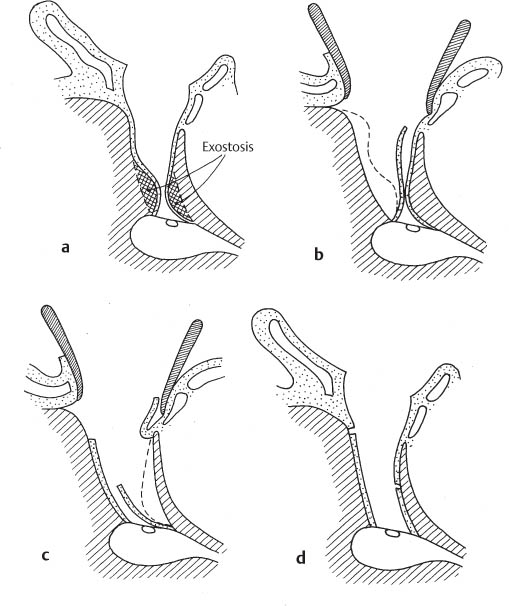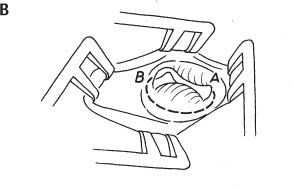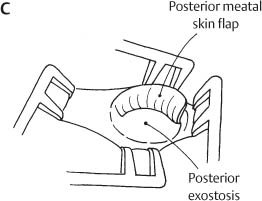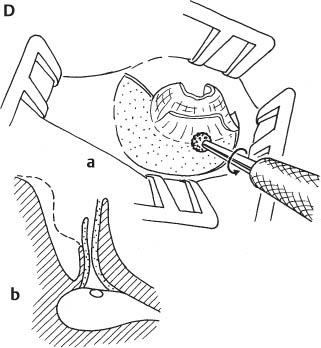Chapter 4 Special Applications with Tympanoplasty Transcanal myringotomy with ventilating tube (grommet) is used when chronic serous otitis media is accompanied by a conductive hearing loss of 30 dB or more. Temporary ventilating tubes are used first. If a repeated temporary ventilation tube fails, a permanent ventilating tube is introduced. A myringotomy alone is used as symptomatic treatment in: acute suppurative otitis media, barotrauma, and as an adjunct procedure in acute mastoiditis. Myringotomy with a ventilating tube is rarely used in conjunction with tympanoplasty. In the latter case, a transmastoid drain is preferred (see Fig. 56, p. 112). This enables the middle ear to be cleaned of secretions and secures postoperative ventilation. This procedure is performed under general anesthesia for children and local anesthesia for adults. Local anesthesia is provided with Gingicaine spray (2% tetracaine) applied over the tympanic membrane 5 minutes prior to myringotomy.
 Transcanal Myringotomy with Ventilating Tube
Transcanal Myringotomy with Ventilating Tube
 Temporary Ventilating Tube (Grommet)
Temporary Ventilating Tube (Grommet)
Surgical Technique
Surgical Highlights |
|
Surgical Steps
Fig. 64A
Ear speculum
The ear speculum is introduced and kept in place with the left hand.
Fig. 64B
Myringotomy
The myringotomy is performed with a myringotomy knife in the anteroinferior quadrant of the drum. A radial incision is preferred to a circumferential one to avoid infolding of the margins of the incision and subsequent formation of cholesteatoma (see also Fig. 7B). The length of the incision should match the diameter of the inner flange of the Grommet. The incision should avoid the tympanic annulus. In the presence of a retracted drum, the myringotomy should be made within the deepest available space in the hypotympanum.
Fig. 64C
Transportation of the ventilating tube
Many kinds and shapes of ventilating tubes are available. If no commercially manufactured tubes are available, it is possible to obtain “home-made” polyethylene tubes of various sizes (PE 50, PE 60). The flanges of the tubes are created by placing the cut end of the tubes over a hot metal surface. The tubes are sterilized prior to use. The tube is picked up using a 1.5-mm, 45° hook and placed in Ringer’s solution. The alternative to the hook is to use a large straight alligator forceps to pick up and transport the ventilating tube. A wet ventilating tube is less prone to sliding away along the tympanic membrane during placement.
Fig. 64D
Transportation of the ventilating tube (cont.)
The ear speculum is kept in position with the left hand, and the ventilating tube is introduced into the EAC with the right hand.
Fig. 64E
Ventilating tube on the tympanic membrane
The tube is placed on the tympanic membrane close to the myringotomy opening.
Fig. 64F
Introduction of the ventilating tube
The 1.5-mm, 45° hook (29-I) is used to place the inner flange of the tube over the myringotomy incision.
Fig. 64G
Introduction of the ventilating tube (cont.)
The inner flange of the tube is rotated into the tympanic cavity using the 1.5-mm, 45° hook.
 Permanent Ventilating T-Tube (Grommet)
Permanent Ventilating T-Tube (Grommet)
Surgical Technique
For permanent ventilation our preference is a Goode T-Grommet, Xomed Product No. 40812. This tube remains in place for up to 3 years. Thereafter, a chronic perforation of the tympanic membrane may result in 10% of the cases.
Surgical Highlights |
|
Surgical Steps
Fig. 65
Permanent ventilating T-tube
a Goode T-grommet silicon ventilating tube.
b The flanges of the tube are grasped with a large smooth alligator forceps (45-I).
c Trimming the flanges of the T-grommet.
d Modified T-grommet ready for introduction.
e Myringotomy in the anteroinferior quadrant of the drum.
f The flanges of the T-ventilating tube are grasped with a small smooth alligator forceps (44-I) and inserted through the myringotomy incision.
g Final position of the T-ventilating tube.
 Temporary Access to the Round Window
Temporary Access to the Round Window
Temporary access to the round window may be required for the application of drugs to the middle ear and round window niche. This approach was also used in the beginning of the cochlear implant era for introduction of temporary round window electrodes. This application will be used to demonstrate the surgical steps of the procedure.
Surgical Technique
A temporary round window electrode is used to test whether a patient with bilateral deafness is suitable for a cochlear implant.
Surgical Highlights |
|
Surgical Steps
Fig. 66A
Endaural skin incision
The helicotragal incision is carried out as for stapedotomy.
Fig. 66B
Tympanomeatal flap
The posterior limbs of the tympanomeatal flap are carried out more caudal than for stapes surgery.
Fig. 66C
Exposure of the round window
The tympanomeatal flap is elevated and the chorda tympani dissected free. The round window niche is exposed below the chorda.
Fig. 66D
Electrode notch drilled in the posterior canal wall
A notch for fixation of the electrode is drilled (Fisch PM Micro, p. 376) with a diamond burr in the posterior canal wall. The direction of rotation of the burr is away from the chorda tympani.
Fig. 66E
Insertion and fixation of the electrode
The ball end of the insulated platinum iridium electrode is applied on the round window membrane. If necessary, the electrode is fixed in the notch of the posterior canal wall with a drop of Histoacryl glue.
Fig. 66F
Threading of the electrode through the posterior canal wall
The posterior end of a large injection needle is cut away with strong scissors to allow passage of the electrode. The injection needle is introduced from the retroauricular skin into the lumen of the EAC. The lateral end of the electrode is passed through the needle and brought out behind the pinna.
Fig. 66G
Retroauricular fixation of the round window electrode
Steristrips are used to fix the electrode in the retroauricular region. The electrode remains in place for 2 days. After testing, the electrode is removed by pulling it through the skin. Care must be taken to use a very small amount of glue to fix the electrode to the notch in the posterior canal wall to avoid pain when removing it.
 Canalplasty for Exostosis
Canalplasty for Exostosis
Surgical Technique
Indication. Retention of cerumen and keratin in the external canal with recurrent episodes of external otitis.
Surgical Principle. Removal of external canal exostoses requires complete elimination of overhanging bone lateral to the tympanic annulus. The shape of the bony external canal should be an inverted, truncated cone. The meatal skin flaps should be kept intact to promote rapid reepithelization of the enlarged canal. To keep the canal skin intact, the posterior bony overhang should be removed first and the anterior second.
An alternative approach for exostosis is to combine this procedure with a meatoplasty (see Figs. 19A–G). The skin incision used for meatoplasty does not only enable removal of the excess conchal cartilage to produce a large, cartilaginous external canal, but also ensures excellent visibility of the exostotic posterior canal, which is enlarged first. The superior and inferior canal incisions can be prolonged medially to form the posterior and anterior meatal skin flaps required for the canalplasty.
Surgical Highlights |
|
Fig. 67
Principles of canalplasty for exostosis
a Preoperative view showing narrowing of the canal due to the exostosis.
b Elevation of posterior, medially based meatal skin flap and removal of posterior exostosis.
c Elevation of anterior meatal skin flaps. This includes a longer, laterally based and a smaller, medially based flap. Elevation of these flaps allows the removal of anterior exostotic bone.
d Completed canalplasty.
Surgical Steps
Fig. 68A
Skin incision
Helicotragal incision as for stapedotomy. The alternative is the same incision as for meatoplasty (see Fig. 19C, p. 40).
Fig. 68B
Posterior meatal incision
The entrance of the EAC is enlarged with two Fisch endaural retractors (see Instrumentation). A posterior semicircumferential incision (A–B) is carried out along the lateral edge of the exostotic bone. The broken line indicating the incision in the figure is not placed correctly and should be advanced to the edge of the exostosis. This will shorten the posterior meatal flap, allowing better visualization of the posterior exostosis.
Fig. 68C
Elevation of the posterior meatal flap
The skin is elevated over the posterior exostotic bone. Vertical incisions along the bony canal wall are carried out at 12 o’clock and 6 o’clock using tympanoplasty microscissors (52-I, 53-I). If the procedure is combined with a meatoplasty, the vertical skin incisions are a prolongation of the two vertical meatoplasty incisions (see Fig. 19D, p. 40).
Fig. 68D
Removal of posterior exostosis
a
Stay updated, free articles. Join our Telegram channel

Full access? Get Clinical Tree


 Local anesthesia (adults), general anesthesia (children).
Local anesthesia (adults), general anesthesia (children). Transcanal approach through ear speculum.
Transcanal approach through ear speculum. Radial myringotomy in anteroinferior quadrant of tympanic membrane.
Radial myringotomy in anteroinferior quadrant of tympanic membrane. Transportation of grommet with a 1.5-mm, 45° hook or with an alligator forceps.
Transportation of grommet with a 1.5-mm, 45° hook or with an alligator forceps. Introduction of inner flange of grommet through myringotomy opening.
Introduction of inner flange of grommet through myringotomy opening.
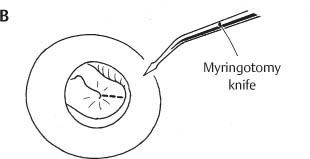

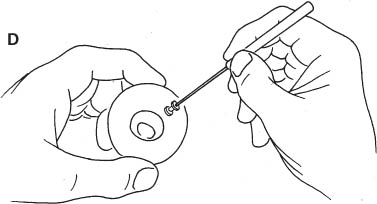
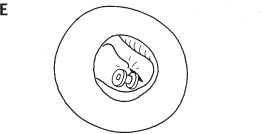
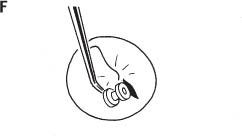
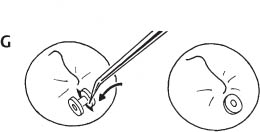
 Local anesthesia (adults), general anesthesia (children).
Local anesthesia (adults), general anesthesia (children). Modification of T-tube.
Modification of T-tube. Introduction of T-tube with an alligator forceps.
Introduction of T-tube with an alligator forceps.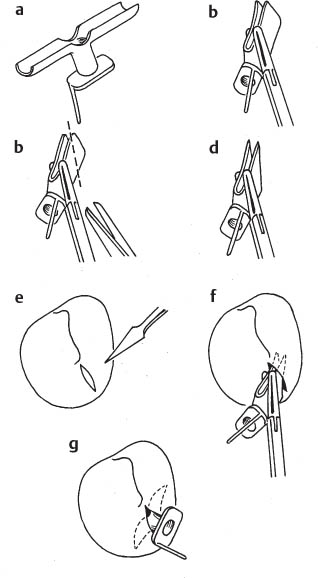
 Local anesthesia.
Local anesthesia. Endaural approach.
Endaural approach. Limited tympanomeatal flap.
Limited tympanomeatal flap. Notch for electrode drilled in posterior canal wall below chorda tympani.
Notch for electrode drilled in posterior canal wall below chorda tympani. Fixation of electrode on round window membrane and in notch of external auditory canal.
Fixation of electrode on round window membrane and in notch of external auditory canal. Threading of electrode through meatal skin in postauricular region.
Threading of electrode through meatal skin in postauricular region.
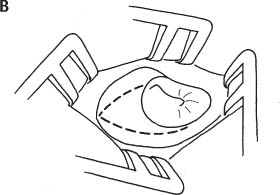

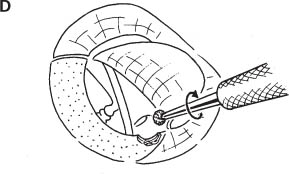
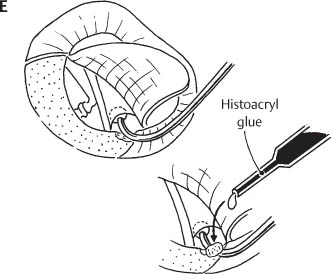
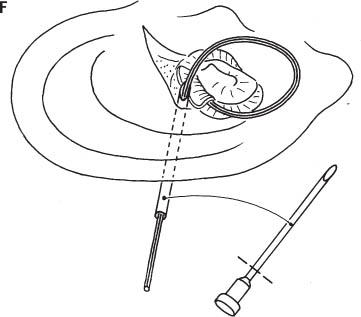
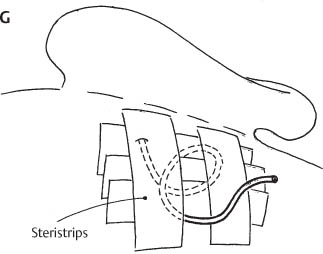
 Endaural approach.
Endaural approach. Posterior and anterior meatal skin flaps.
Posterior and anterior meatal skin flaps. Total removal of bony overhangs lateral to tympanic annulus.
Total removal of bony overhangs lateral to tympanic annulus. Replacement of preserved meatal skin flaps.
Replacement of preserved meatal skin flaps.